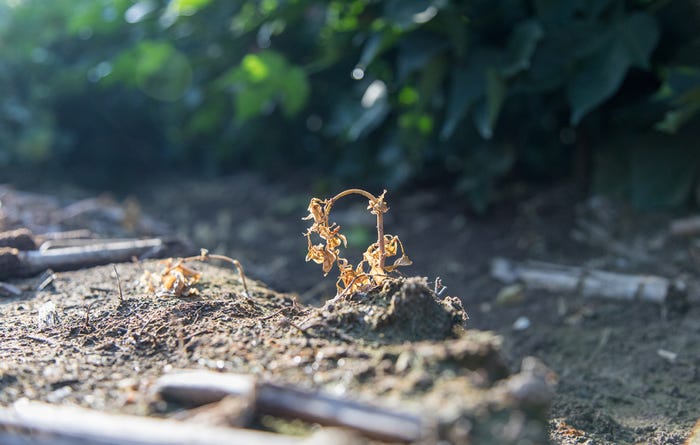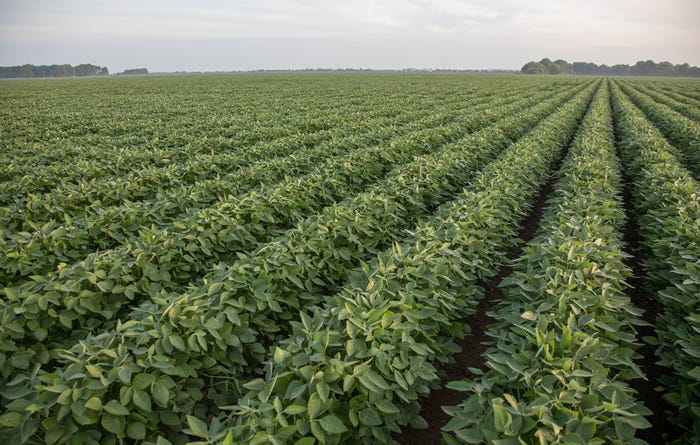February 1, 2024

Herbicide-resistant weeds are a significant threat to soybean, cotton and corn yield potential — and the future of crop production.
“Because weed resistance is naturally occurring, it’s a myth that we can create a silver bullet that’s impermeable to resistance pressure,” says Todd Spivey, market development specialist, Corteva Agriscience. “We must protect our strongest and most reliable products by using multiple measures that will help prevent the selection and buildup of resistant weeds.”

“Before a herbicide application is ever made you should know what weeds are present, what size they are and how many there are,” says Todd Spivey, market development specialist, Corteva Agriscience. Photo submitted by Corteva Agriscience.
The following six actions can help you prevent increased weed resistance on your operation:
1 . Know the signs. Identifying weed resistance on your farm isn’t an indication of poor management. By knowing if resistant weeds are on your farm, however, you can equip yourself with the information and resources to tackle difficult weeds moving forward.
The best time to diagnose for possible resistance is immediately following a herbicide application. Find an area where weed density is sparse so you are sure all weeds received equal amounts of herbicide; a spot that has all the same weed species is ideal. Did you find some weeds controlled, some looking like they haven’t been sprayed and some lingering in between? This is usually how weed resistance starts to express itself.
2 . Scout fields regularly. “Before a herbicide application is ever made, you should know what weeds are present, what size they are and how many there are,” Spivey says. “Continuous scouting before and after applications is the only way to determine the effectiveness of any weed management program.”
Spivey recommends keeping a weed journal to note which weed species are present and in what proportion. Keeping regular records will help you notice shifts on your farm. “Having this information in writing is important, as none of us have the memory that we think we do,” Spivey says.
Specific scouting trips after herbicide applications will help you gauge herbicide efficacy. The information from these immediate scouting visits, coupled with regular weed journal notes, will help develop a baseline for any changes that occur over time. If misses or failures occur, you can decide how to correct the lack of control and determine the cause as soon as possible.
3 . Take immediate action when resistance is suspected. “If resistance is suspected, you’ll want to control the weed in question with a labeled herbicide that includes another mode of action or with nonchemical weed control,” Spivey says. “This is vital to prevent the weeds from going to seed.”
4 . Rotate herbicide modes of action. Always use multiple effective modes of action with every herbicide application. “This can be accomplished with a program approach that includes two- and three-way premixes or by tank-mixing multiple products,” Spivey says. “Effective is the key word here. Including glyphosate in a tank mix when trying to manage glyphosate-resistant weeds does not count as an effective mode of action.”
For Enlist E3® soybeans and Enlist® cotton Spivey recommends applying a residual herbicide preemergence followed by one or two postemergence applications of an Enlist® herbicide and qualified tank-mix partners. Including a layered residual in your postemergence application can help control weeds until the crop reaches canopy.
Learn more about scouting and a program approach to control weeds long term.
5 . Rotate crops. Rotating crops allows you to use additional herbicides and modes of action. “For example, growers can take advantage of the HPPD-inhibiting products for broadleaf control in corn and utilize the ACCase inhibitors for grass control in soybeans,” Spivey says.
6 . Advocate for weed resistance prevention strategies. Herbicide resistance issues are not isolated to one farm. Ditches, leased and traded land, and used and traded equipment are all sources of herbicide-resistant weed seed, so the prevention of herbicide resistance must be a concerted effort from all parties.

Always use multiple effective modes of action with every herbicide application. Photo submitted by Corteva Agriscience.
“Our ability to provide new active ingredients to the market is outpaced by growing weed resistance pressure,” Spivey says. “Because of this, it is vital that growers implement strategies now to prevent weed resistance versus waiting to address the issue in the future.”
Work closely with your neighbors and local experts to develop a weed resistance prevention plan if you haven’t already. Your local crop protection retailer and Corteva Agriscience representative are always here to help. You also can visit IWillTakeAction.com to learn more about managing weed resistance.
™ ® Trademarks of Corteva Agriscience and its affiliated companies. The transgenic soybean event in Enlist E3® soybeans is jointly developed and owned by Corteva Agriscience and M.S. Technologies L.L.C. Enlist Duo® and Enlist One® herbicides are not registered for sale or use in all states or counties. Contact your state pesticide regulatory agency to determine if a product is registered for sale or use in your area. Enlist Duo and Enlist One herbicides are the only 2,4-D products authorized for use with Enlist® crops. Consult Enlist® herbicide labels for weed species controlled. Always read and follow label directions. ©2024 Corteva.
You May Also Like





